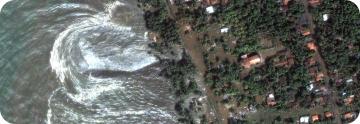The horrific images remain vivid long after the Asian tsunami of 2004: An unstoppable wall of water surging inland, flattening buildings, tossing around cars like bathtub toys, sweeping adults and children out to sea. It killed more than a quarter of a million people - all because the ocean floor moved.
 Flooding on the coast of Sri Lanka, December 26, 2004. Photo: NASA
Flooding on the coast of Sri Lanka, December 26, 2004. Photo: NASAA tsunami is one of the most powerful and destructive natural forces. And almost every coastline is at risk. Yet with the right equipment, scientists can predict where a tsunami will hit up to several hours in advance.
Several events can trigger a tsunami. The most common is an earthquake. In the 2004 tsunami, the quake took place when one continental plate suddenly slipped past another. This cracked the ocean floor, displacing massive amounts of water and creating broad, flat waves.
When they’re in the open ocean, the waves are only a few feet tall, and the distance between individual waves can be hundreds of miles. But as they reach the shore, the waves slow down and get taller. Some can tower as high as a six-story building.
The last major tsunami to hit the United States came in 1964 after a quake in Alaska. It sent some of the most destructive waves ever recorded crashing into Hawaii. It also killed more than a hundred people, and caused damage all along the West Coast.
Modern technology allows scientists to monitor these waves, and to predict when and where they’ll hit. Advance warning won’t keep a tsunami away, but it may give people some time to escape.
copyright: Damond Benningfield

